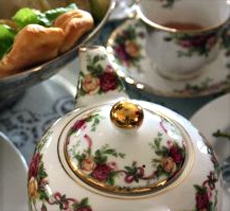Pairings: An OverviewIn the regions of China, Japan and India, cuisine and the varieties of teas evolved together—just as cuisines and wines evolved to complement each other in the West. Like wines, teas have numerous styles and many different flavors. When matching the hundeds of available teas with Western cuisine, I would like to tell you that pairing food with tea is a science; but in reality, pairing relies greatly on an individual’s palate in an exploration of the natural interplay between food and tea. “In the end, goodness is for the mouth to decide,” wrote Lu Yu in the Cha l’ Ching, the classic “Book of Tea,” a systematic codification of tea information that was published in 780 A.D. Long served as an after-dinner libation, pairing tea with food during the meal is a marvelous way to both heighten the dining experience and expand one’s acquaintance with the vast universe of teas and their varying profiles. To be able to enhance the food and emphasize the flavors of a given tea is mutually rewarding. Today, more dining establishments offer extended tea menus. When I discuss the importance of pairing tea and food with managers and waitstaff, I always stress that the best that can be offered to them is a guideline—a helping hand to achieve a nicely balanced list of teas that complements the food offered by the establishment. Whether the diner orders rack of lamb or bagels and cream cheese, the process doesn’t have to be any more complex. It’s the same when you’re deciding on food and tea matches at home. You’ll probably be relieved to know that tasting doesn’t require an extremely sophisticated knowledge of food or tea. If you already enjoy food on any level, then you probably have some tasting vocabulary. Start by talking about the characteristics of what you’re eating and drinking. Never be afraid to describe what comes to mind when you are tasting tea, because no impression is too slight, and there is no wrong answer—it’s all what you experience. As with looking at modern art, one person’s perceptions help another person see things in a new light. (Editor’s note: in many category sections of THE NIBBLE, we provide glossaries and tasting terms, including a glossary of tea terms.) To illustrate my point, let’s take a complex but marvelous example—oolong.
So what does it all mean? Now that you have broken down the complex profile of a single tea, you should understand how important it is to match that profile with complementary smells, textures and flavors of food.
This also may seem like a lot for a beginning taster to learn. You’ll know when you’ve discovered the perfect marriage of flavors, but take some comfort in the guide on the next few pages.
Continue To Page 2: Pairing Tea With Breakfast & Brunch, Cheese, And Chicken Return To The Article Index At The Top Of The Page
Lifestyle Direct, Inc. All rights reserved. Images are the copyright of their individual owners.
|

The Nibble Blog
The Latest Products, Recipes & Trends In Specialty Foods
The gourmet guide you’ve been waiting for. New food adventures are served up daily. Check it out!

Food Glossary
Our Food Directories Are "Crash Courses" In Tasty Topics
Your ultimate food lover’s dictionary packed full of information and historical references. Take a look!

Food History
Let the journey begin!
Learn about the history Of 1,000+ Favorite Foods & Beverages Let’s explore the history of your favorie goods together.Let the journey begin!


